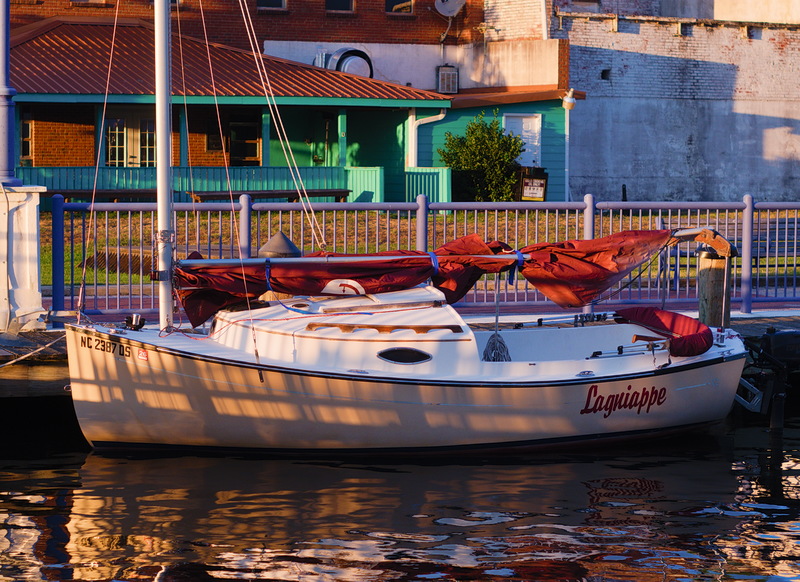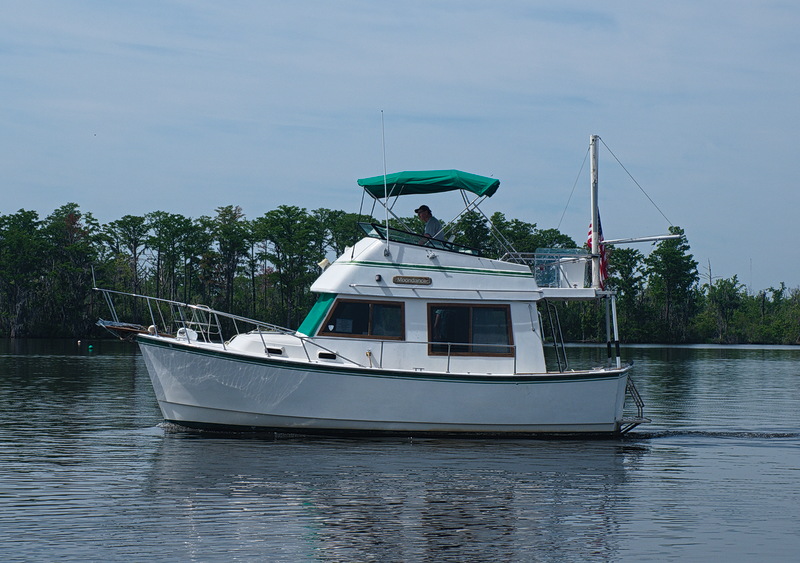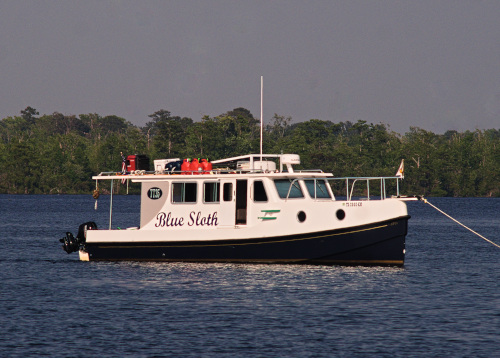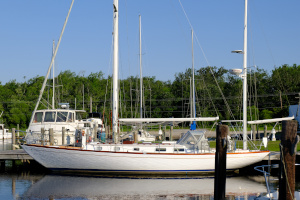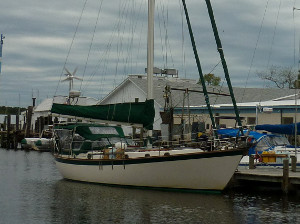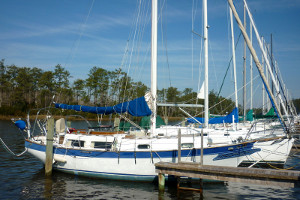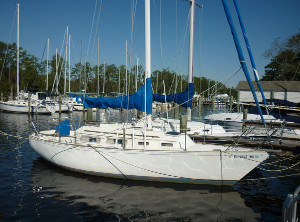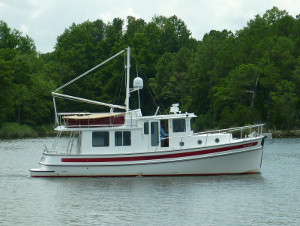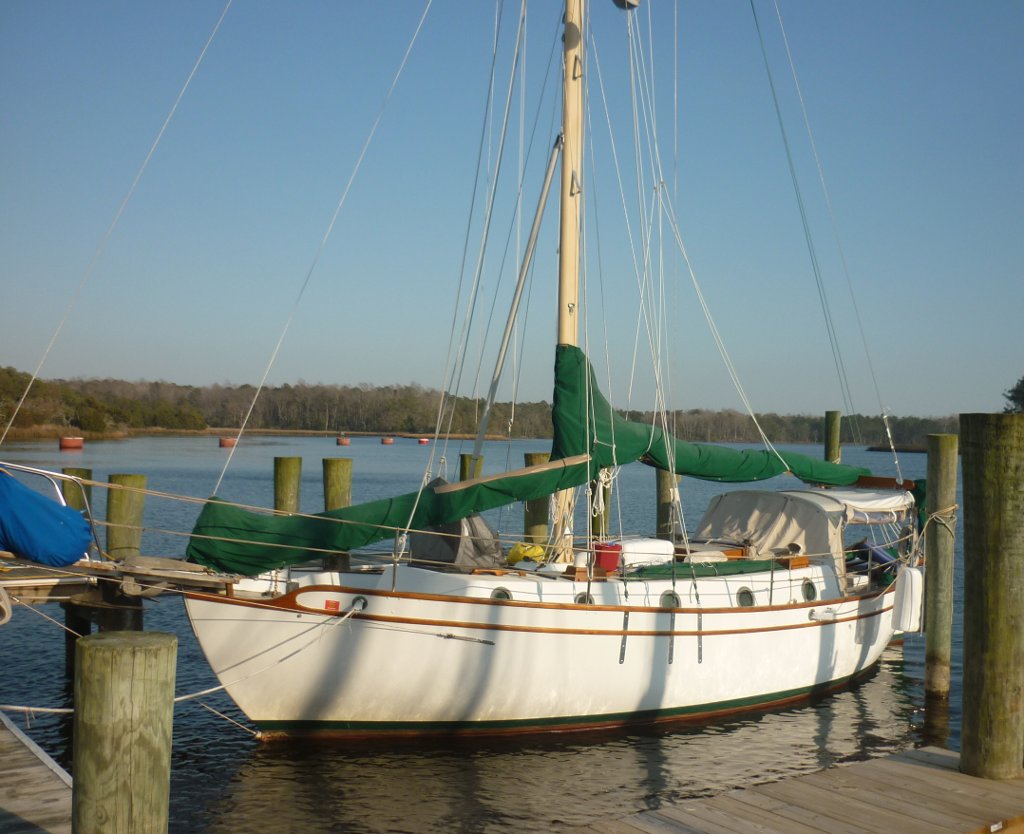Com-Pac Sun Cat 17-2
Builder: Com-Pac (USA)
Designer: Clark Mills
Number Built:500+
Years Built: 2000-2025
When I first saw this boat on the dock in Little Washington, it had me puzzled. It had a faint familial resemblence to the classic Com-pacs of yore, but looked too new. Surely the illustrious old company had followed the other great old names of the 1960s and 1970s into oblivion. And it has, finally closing down this year of 2025, but not for the usual reasons of overextension, poor management and shoddy workmanship. The two sons of company founder Les Hutchins, founder of the company way back in 1957, had operated the company since his retirement many years ago. Now one of them has passed away and the other is ready for a well-deserved retirement. Maybe someone will pick up the molds and continue the line under a new name.
This 17 foot gaff-rigged catboat is of a type familiar to harbors all along the eastern seaboard going back 150 or more years. The boat has a shallow keel with a substantial deep centerboard but I still wouldn't expect too much windward performance. The little kicker hung on the stern should be enough to creep up into a snug anchorage to ride out adverse winds.
The boat weighs a scant 1,500 pounds and is easily trailerable. As clean as the one in the photograph is, I expect it has been kept in a carport or garage for most of the 19 years since it was built in 2006. The Sun-Cat 17 is a perfect example of all that is good and wholesome about a small sailcraft.
Atlantic 30
Builder: Atlantic Yachts
Designer: J.B. Hargrave
Number Built: ?
Years Built: 1982-1986?
Originally the Prairie 29 dating back to 1977, Prairie Yachts closed in 1982 and the molds were acquired by Atlantic Yachts. The boat was designed to be fuel efficient, safe, comfortable and under 30 feet on waterline. I saw one on the Washington City Dock in May 2024 and it looked to meet all criteria. The designer went on to draw boats for Hatteras Yachts.
Dana 24
Builder: Pacific Seacraft
Designer: Bill Crealock
Number Built: 250
Years Built: 1984-2007
Bill Crealock's design for a pocket bluewater cruiser, the boat features heavy fiberglass construction and a full keel with substantial cutaway at the bow. Most if not all feature tiller steering. The LOD is 24 feet, and the bowsprit adds three more. Beam is 8 1/2 feet, and the draft is just under 4 feet. The boat is ostensibly trailerable, but I have to believe most of them stay in the water. It is easily identifiable by the bluff bow and stern, high house, external chainplates and trademark Pacific Seacraft rubrails. Around 250 were built by Pacific Seacraft between 1984 and 2007, but it is possible a few more were built earlier, before Pacific Seacraft got rights to the design. Rumor has it that a company in Portland OR got the molds after the Pacific Seacraft bankruptcy in 2007, and may have built a few more. (Pacific Seacraft was bought out of bankruptcy by local interests in Washington NC and continues to build and refurbish boats to this day.)
Witness 35
Builder: Witness Catamarans (USA)
Designer: Lock Crowther
Number Built: 8?
Years Built: 1981-?
Designed by noted Australian designer Lock Crowther, these boats are built of cored fiberglass and feature twin daggerboards for performance to windward. As built they incorporated twin Nanni 13 horsepower diesels, one in each hull, but the pictured boat has been converted to a center-mounted Honda 25 horsepower outboard.
I had the pleasure of crewing for the owner of Oryoki in moving the boat from Edenton to Florida in 2018. Due to adverse weather we ran the ICW the whole way and didn't get much opportunity to sail, but when we did, I was favorably impressed by how well, for a catamaran, the boat pointed. The Honda motor moved the boat at hull speed without straining, and the 17 foot beam made for a stable and comfortable ride, and plenty of interior volume. I would consider the Witness 35 to be a great ICW runner, and with its draft of just over 2 feet with the boards up, it would probably be a fine island hopper. Reputedly, these boat handle blue water with aplomb.
Compared to more modern cats, these boats might be considered narrow, heavy and slow, but they are strong and easy to handle. As far as I can tell, only eight were built, but they do come up for sale on occasion, and someone looking for a well-designed, reasonably priced catamaran could do worse.
TT35
Builder: Great Harbour
Designer:
Number Built:
Years Built: 2017 - Current
I saw this distinctive-looking boat at Manteo and again at Elizabeth City. Evidently this model can be trailered and hauled by a 3/4 ton truck with what a reviewer describes as "a standard over-wide transportation permit". It is powered by twin outboards in the 60-100hp range and features a 16" draft allowing it to enter almost any water. The cored hull and a lot of high-tec materials make for a 7,000 pound displacement, so it is easily powered.
This is an innovative design without much reference to traditional naval architecture. I would say that it is intended as an ICW and Great Loop runner.
Reviews have been positive, but be sure to see this thread at Trawler Forum if you want to know about the tribulations of buying Hull #1. Everything is happiness and love down to posts #10 and #12, when forebodings of problems begin. Things get interesting at post #20.
Stone Horse
Builder: Edey & Duff
Designer: Samuel Crocker
Number Built: 38 in wood, 150 in fiberglass
Years Built: 1931-2009
Massachusetts naval architect and builder Sam Crocker studied under John Alden and then set up his own shop, where he developed a reputation as one of America's finest designers. The Stone Horse was laid out to handle the rough waters of Buzzards Bay and provide shelter for occasional overnighting. 38 were built of wood prior to World War II, and there things could have ended, with just a chapter in the classic "Sam Crocker's Boats". However, in 1968 the Mattapoisett MA manufacturer Edey & Duff started making Stone Horses in fiberglass, and went on to build 150 of them before the yard closed in 2010.
The Stone Horse is easily recognizable by its raised deck design, cutter rig with either or both foresails on booms, and tiller steering. The hull spans 23 feet, with the bowsprit and boomkin adding three more. The sample pictured is Neuse River sailor David Swanson's fiberglass Flying Beagle at TJ's Yard in Belhaven.
Nimble 30
Builder: Nimble Boats (USA)
Designer: Ted Brewer
Number Built: 29
Years Built: 1985-1997
These distinctive canoe stern boats were made in sloop or yawl configurations, with or without centerboards. The designer, Ted Brewer, was one of the greats, and purportedly owned one of these boats for a while. The high freeboard, width carried far into the ends, and substantial cabin give the appearance of a boat much larger than it's 30 feet, and this is partially true. The interior volume is considerable, but the boat is strikingly light, with a listed displacement of 6,500 pounds. Compare that to a Southern Cross 31, with a displacement of 13,600 pounds. Even the ubiquitous Catalina 30 comes in at over 10,000 pounds. (I have seen suggestions that the true displacement is closer to 8,000 pounds, still quite light). Power is a 12 hp Yanmar.
I found Cat's Paw docked two slips over from Terry Ann at Albemarle Marina. The owner graciously invited me aboard for a tour. I found a lot to like, including the tiller steering, yawl rig, opening bronze portlights and a short bow platform for carrying the anchor. The headroom is 6'3", plenty for most sailors. There is a central table with drop leaves mounted over the centerboard trunk. Watch the mechanism for extending the leaves, it's bitey, I've been told.
Mainship 34 Diesel Cruiser Mk 1
Builder: Mainship Corporation
Designer: John Cherubini
Number Built: ?
Years Built: 1978-1982
In 1978 the Luhrs family boat-building conglomerate that included Hunter, Luhrs and Silverton set up a new company, Mainship, to produce a John Cherubini designed 34 foot trawler. Eventually the family sold out, but the Mainship Corporation builds boat to this day. The founding philosophy was to build a line of simple, no-frills boats that were economical to buy and run.
When I first saw Osprey on the Deaton's dock in Oriental I was struck by her classic lines, and when I saw the sliding glass doors between the cockpit and main saloon that looked like they were sourced from Home Depot I immediately thought "Mainship". The hull identification number starting with "MPC" proved it.
Many years ago I sailed Valor down the ICW to the Waccamaw River and then back to my home marina at Southport. On the return trip, I pulled in to Barefoot Landing late in the afternoon and found a spot to tie up directly behind a Mainship. This was in the days when you could dock overnight at Barefoot Landing. The owner invited me aboard for drinks and I had a pleasant conversation with him and his female crew. It seems that, other than a few small fishing skiffs, the man had never owned a boat or had any desire to. But in a state of mid-life crisis, he suddenly decided that he wanted to run the entire length of the ICW aboard his own boat. He lucked into a Mainship, just the ticket for that sort of thing, and put out word of his plans and desire for crew. A friend of a friend volunteered, and they started north. Here they were in South Carolina, close to half way, with no major problems or issues, despite their near-total lack of boating experience. As I said, we had a pleasant evening drinking and telling stories, though each found an opportunity to get me alone and tell me how insufferable the other was. Ever since I have had a soft spot for Mainships.
Bay Hen 21
Builder: Various
Designer: Reuben Trane
Number Built: ?
Years Built: 1984-2003
A boat that you can sail around the Oriental inner harbor. Designer Reuben Trane drew a whole line of small, shallow-draft boats that were built by a series of companies that drifted into existence, lived for a while and then passed into bankruptcy. The last known owner of the molds was Nimble Boat Works, maker of the celebrated Nimble Nomad trailerable cruiser. The little catboat draws three and a half feet with the centerboard down, nine inches with the board up. A well at the back of the cockpit will hold a small outboard for auxiliary power. Rigged up with a boom tent, it looks like it would make a fine camping boat for exploring the shallow bays and creeks along the Pamlico Sound.
Designer Trane seems to have been fixated on poultry, drawing in addition to the Bay Hen - the Peep Hen, the Mud Hen and the Marsh Hen. Later, he was a principal in the Kadey-Krogen Yachts Company. Currently he is marketing director for Castleman Marine, tugboat builders.
CSY 37
Builder: Caribbean Sailing Yachts
Designer: Peter Schmitt
Number Built: 82
Years Built: 1978-1981
These idiosyncratic boats are easy to identify, once you see the first one. The clipper bow, raised deck and numerous portholes in the cabin and the hull, boomed staysail and general appearance of solidity make it hard to mistake this boat for any other. The long, sturdy rubrails, akin to those on Pacific Seacrafts, are a feature that I greatly admire. Built for the charter trade, with lots of interior volume, the CSY 37s have developed a following among live-aboards. There is no coring, hull or deck, which makes for springy decks, nothing to worry about. The hull is laid up with close to two inches of fiberglass. Compared to my Alberg 35, this boat is 2 feet more LOA and just under five tons more displacement. The pictured example, in Edenton NC in August 2020, had just completed a slog up the ICW from St. Augustine, complete with extra fuel and water jugs in case of Covid-19 effected resupply shutdowns. The live-aboard owners love their home, though one confided to me that the boat "sails like a barn."
Chesapeake 32
Builder: Danboats
Designer: Philip Rhodes
Number Built: 95
Years Built: 1960-1965
This classic fiberglass Philip Rhodes design was built in Denmark, with most copies exported to France or the U.S. It was on my short list when I was looking for something to replace Valor, and I came very close to driving to New England to see one that was for sale. As far as I am concerned, this boat has perhaps the best lines of any that I know of, very traditional, with a full keel with lots of cutaway at the bow, long overhangs and narrow beam. Good lines usually predict seaworthiness, and owners rave about the ability of their Chesapeakes to handle heavy weather. The solid 'glass hulls are pretty much bullet-proof, though of course all the usual issues with 50 year old boats are apparent. But for the owner willing to recore the decks, replace the engine, update the standing rigging and apply lots of elbow grease and paint, the result will be a true classic from the early age of fiberglass.
The accompanying photograph of Chesapeake 32 Content was graciously supplied by her owner, Bob Senseney. Content sails the waters of the Chesapeake Bay.
Rosborough Destiny
Builder: Rosborough Boats
Designer: James Douglas Rosborough
Number Built: About 150
Years Built: 1955-1993
If you see one, you will know what it is. These little ketches, custom-built in sizes from 30 to 40 feet in length (including the long overhanging bowsprit and boomkin), are unmistakeable. They were built in wood until 1993, though fiberglass hulls were available after about 1990. The yard was, and still is, in Halifax NS, but the days of building sailboats are long gone. Now they specialize in semi-custom small boats for police, search and rescue, oil platform assistance, and such.
The pictured boat was found in Portsmouth VA in 2017. I believe this is the "Annie Laurie", the very last Rosborough built of wood.
Migrator Block Island 40
Builder: Migrator Yachts, Inc.
Designer: William Tripp
Number Built: 17
Years Built: 1984-1999
Bill Tripp designed this boat and the first copies were built in 1957. Migrator Yachts got rights to the design in 1984 and began building it in fiberglass. It has a distinct resemblance to a Hinckley Bermuda 40, no surprise since both boats came from the same designer, in the same era. The Block Island 40 is usually found in yawl rig, though it is possible that some from the pre-Migrator era were rigged as sloops. The boat draws just over 4 feet, with an additional 4 feet of centerboard.
How many Block Island 40s have been built? It's hard to say, because the molds have changed hands several times, but the 17 built by Migrator still command a substantial price on the used boat market. The boat, with it's yawl rig, low freeboard and limited interior volume is out of style now, but it's impossible for a traditionalist not to love it.
Glander Tavana 33
Builder: Glander Boats Inc.
Designer: Harold S. Glander
Number Built: 134
Years Built: 1961-1988
This is a boat that, in a lifetime on the water, you may see just once or twice. Harold Glander built a keel/centerboard, shallow draft yawl out of fiberglass for himself in 1956, and in 1961 went into production of the Tavana, closely modeled on his own boat. Over the next 21 years, he produced a few hundred boats in kit form, to be completed by the purchaser, of several classes.
Evidently, some of the Tavanas were set up with sloop and ketch rigs, but yawls predominated. They are purported to be heavy, seaworthy boats, well-loved by their owners. Aesthetically, the high cabin is a bit odd, but I expect that's what was needed to provide standing room with the shallow draft and low freeboard. This is the kind of idiosyncratic boat produced by a true sailing enthusiast that keeps things interesting for the dockwatchers.
A reader sent me this about the boat - "As to the Glander 33, as a young adventurous man of 22, I and 2 friends whom had little knowledge of sailing bought a Glander 33 sloop in Miami and spent 3 months sailing her around the Bahamas finally ending up in Jamaica, then back to Florida. She was the best boat, whether in shallow water or deep water of the Windward Passage and the Caribbean".
George, the owner of the Glander in Edenton showed me around his boat. I found plenty of headroom, a wide cabin sole and spacious settees. The interior woodwork was well-done and attractive. The only drawback was difficult access to the sides and back of the engine. George also informed me that the boat was reviewed in the February 2011 issue of Southwinds, which can be viewed or downloaded here. Sailrite has a data sheet for the boat that shows sail dimensions here. And finally, Good Old Boats Magazine has a flash video tour of a Tavana here.
Tartan 34
Builder: Tartan Marine
Designer: Olin Stephens
Number Built: 525
Years Built: 1968-1978
For the time, this boat was considered a high-performance cruiser, with a short fin keel, rudder on a skeg and big centerboard, and even now is capable of fast passages. With a fairly high freeboard, there is plenty of headroom in the narrow cabin, and the nine-foot cockpit can hold a party. The mainsail is high aspect, and most examples sheeted to a traveler in the cockpit. This one has a long boom to allow for sheeting all the way aft.
You will often find this boat referred to as a 34C, for "classic", to distinguish it from later Tartan 34 designs, but that was not an official designation. Some interesting records have been racked up by sailors aboard the Tartan 34. In 1981, Jon Sanders set out aboard one on a double circumnavigation, sailing 419 days and 48,510 miles single-handed without a stop. Several records for youngest circumnavigator were set during the 1990s and 2000s by Tartan 34 sailors. David Dicks completed a non-stop solo circumnavigation in 1996 at age 18. Jesse Martin did the same in 1999 and completed at a slightly younger 18. Jessica Watson sailed her Tartan 34 around the world non-stop solo in 2009-2010 at the age of 16.
Niagara 35
Builder: Hinterhoeller Yachts
Designer: Mark Ellis
Number Built: 260
Years Built: 1978-1990
Traditional appearance above the water line, long fin and spade rudder below. The boat has wide side decks and a big open foredeck to make sail handling safe and easy. The high freeboard and springy sheer remind me of the lines of the Allied Princess. Construction quality and detailing are top-knotch, as is typical for boats from this maker.
Westsail 28
Builder: Westsail Corporation
Designer: Herb David
Number Built: 78
Years Built: 1975-1979
With only 78 built, you are much less likely to see one of these than big sister Westsail 32s, but they share many spotting characteristics - long bowsprit, cutaway bulwarks at the bow, external chainplates and transom-hung rudder, to name a few. The hull form is different, with more cutaway in the forward sections, and the rig is higher in aspect. This makes them a bit more nimble and responsive than the big Crealock-designed, Colin Archer-inspired 32s.
Pied Piper 28
Builder: Liberty Yachts
Designer: Cyrus Hamlin
Number Built: ?
Years Built: 1960-?
The early ones were wood and built by various yards, the later ones fiberglass built by Libery Yachts of Leland NC, not to be confused with Liberty Yachts of Riviera Beach, Fl, builders of the Liberty 38. Easily recognized by its external chainplates and Pacific Seacraft style rubrails. Some were built with a long fin keel, others with a keel-centerboard arrangement. To confuse matters, another boat known as the Pied Piper 28 was built with a completely different profile, flush deck and high doghouse, ostensibly by the same yard. And the Liberty Yachts of Florida built a very similar (as in almost identical) boat known as the Liberty 28.
These boats were built on a semi-custom, commission basis, and the owners had the option to work closely with the builder to get a real one-of-a-kind boat. I have seen pictures of at least one with gorgeous, Hinckley-style cabinetwork.
Fantasia 35
Builder: Tung Hwa Ind. Co. Ltd.
Designer: Bruce Bingham
Number Built: 78
Years Built: 1976-Late 1970s
It's rare to find a center-cockpit boat in the 35 foot range, but designer Bruce Bingham made it work in this beamy Taiwanese-built cutter. The boat features a big aft cabin, a head on one side of the cockpit and a workbench on the other, with a saloon and v-berth forward. The high bulwarks, canoe stern, full keel and powerful dual spreader rig make this a true blue-water boat. It has good antecedents - Bingham also designed the Flicka.
Cape Dory 28
Builder: Cape Dory Yachts
Designer: Carl Alberg?
Number Built: 240
Years Built: 1984-1990
Yes, Cape Dory made powerboats as well as their familiar sailboats, ranging from 24 feet to 40 feet. The various models of the 28 make up most of them, and they are fairly common on the east coast. They feature typical Cape Dory heavy construction in a semi-displacement hull with rounded bilges. They were built with big Chrysler gas engines or Volvo diesels, but many have been repowered. The boats have large open cockpits and pilot houses with comparatively small living areas forward. Some models have flybridges.
I found one site that credited Carl Alberg with the design. Alberg drew most of the Cape Dory sailboats, but whether he also designed the powerboat line I have not been able to confirm.
Com-Pac 23
Builder: The Hutchins Co.
Designer: Clark Mills
Number Built: Many
Years Built: 1978-Current
Designer: Clark Mills
Number Built: Many
Years Built: 1978-Current
Easily recognizable by the external chainplates and tiny portholes, these little trailerable boats are well-regarded by the sailing community. They have been in continuous production since 1978, which must be some kind of record. The boats draw just over two feet, and most are powered by a transom-hung outboard, though a few were built with tiny 10-horse Yanmars.
The designer's name may not be familiar, but the man drew two of the best known sailboats on the water, the Com-Pac 23 and the Optimist pram.
Folkboat
Builder: Various
Designer: Tord Sunden
Number Built: 4,000+
Years Built: 1942-Current
The boat resulted from a design competition in Sweden in 1942. The sponsor, The Scandinavian Yacht Racing Union, couldn't decide on a winner, so they chose the best features of several plans and commissioned Sunden to create a design. He did, and the Folkboat has gone on to race, cruise and sail worldwide for seven decades. The originals were carvel planked, but starting in the late 1960s fiberglass models were (and are) being built. Blondie Hasler raced a modified Folkboat to second place in the first Observer Singlehanded Transatlantic Race in 1960. The heavy iron ballast keel (over 50% of total displacement) makes for a very stiff and seaworthy boat. The fine lines make it fast and the fractional rig makes it easy to sail. I took this photograph at the marina in Brookings OR in 2003.
Freedom 28
Builder: Tillotson Pearson Inc
Designer: Gary Hoyt/Jay Paris
Number Built: ?
Years Built: 1979-?
With an unstayed cat ketch rig, these boats are distinctive and easy to spot. The earliest examples had wishbone booms but later ones, like the one pictured, had conventional booms. Underwater is a long shoal keel and centerboard. There were a whole series of Freedom catboats from 21 to 45 feet, built in the U.S. and by license in Great Britain.
Liberty 38
Builder: Liberty Yachts (USA)
Designer: Joe Fennell
Number Built: 6
Years Built: 1983-1985
With only 6 built (the builder was a casualty of rising resin prices and the luxury tax), you may never see one of these, but they are easy to identify by their external chainplates, canoe stern, high gunwales and cutter rig. To my eye, they look like a big Westsail 32, and the similarities extend to a full keel and heavy displacement. One difference - the rudder is hung under the counter. Another - steering is by wheel rather than tiller.
J/92
Builder: J Boats Tillotson Pearson
Designer: Rod Johnstone
Number Built: 180
Years Built: 1992-2003
J-Boats have proven some of the most popular class racers around. The builder has produced over 9,000 in various sizes and is still going strong.This racy 30-footer sports a retracting sprit for carrying an asymmetric spinnaker. About as far from a heavy displacement cruising boat as one could find, the J/92 normally carries a crew of six for class racing. Looks like it would be a blast to sail - any J/92 skippers looking for rail meat, give me a call.
CS 27
Builder: Canadian Sailcraft
Designer: Raymond Wall
Number Built: 480
Years Built: 1975-1983
Easy to spot with lots of tumblehome and a transom-hung rudder. She has a fin keel and draws just over 5 feet. The designer had been chief designer for Camper and Nicholson before emigrating to Canada and taking the same position with Canadian Sailcraft. The builder was known for quality work.
Downeaster 32
Builder: Downeast Yachts
Designer: Bob Poole
Number Built: 132
Years Built: 1975-1980
Traditional heavy displacement, full keel boats known for quality construction, sea-kindliness and classic lines. Easy to spot by their external chainplates, clipper bows and wineglass sterns. These boats are popular among sailing couples and single-handers.
Sabre 30
Builder: Sabre Yachts
Designer: Sabre Design Team
Number Built: 244
Years Built: 1979-1993
Fin keel, high aspect rig make for a capable racer-cruiser. Built to high standards, these boats are well-regarded in the sailing fraternity.
Alberg 30
Builder: Whitby Boatworks
Designer: Carl Alberg
Number Built: 700+
Years Built: 1962-1984
Another classic Alberg design. Notice the close family resemblance to the Alberg 35 and to the whole line of Cape Dories. Huge fleets of these sail the Chesapeake. The pictured boat is hull #30, built in 1964.
Lightning
Builder: Various
Designer: Olin Stephens
Number Built: 15,000+
Years Built: 1938-Current
The quintessential racing dinghy, also makes a pleasant and tractable day-sailor. Planes easily running downwind under a spinnaker; fractional rig, hard chines and heavy centerboard allow her to go to weather.
Cape Dory Typhoon
Builder: Cape Dory Yachts
Designer: Carl Alberg
Number Built: 2000+
Years Built: 1967-1986
Heavy displacement, full keel in a nineteen-foot package. Tall mast, fractional rig. Auxiliary power provided by a transom-hung outboard.
Nordic Tug 37
Builder: Nordic Tugs
Designer: Lynn Senour
Number Built: 200+
Years Built: 1998-Current
Modern fast trawlers. Full-width saloon with no side decks. Swim platform. Little exterior teak trim. Nordic Tug makes boats ranging from 26 to 54 feet, all sharing a family resemblance.
Lord Nelson Victory Tug
Builder: Lord Nelson Yachts, Inc.
Designer: James Backus
Number Built: 86
Years Built: 1983-1997
The pictured boat is one of 75 37-footers. The remaining 11 ranged in length up to 48 feet. The design cosmetically is based on the Moran working tugs of New York harbor, while below the waterline the boat is based on the traditional Maine lobsterboat hull form. These boats are easy to spot - there is nothing else on the water quite like them.
Southern Cross 31
Builder: C.E. Ryder Corporation
Designer: Thomas Gillmer
Number Built: 150
Years Built: 1976-1987
Stout blue water cruising cutters in the Colin Archer heritage. Double-ended, tiller-steered.
Pacific Seacraft 34
Builder: Pacific Seacraft
Designer: Bill Crealock
Number Built: ?
Years Built: 1984-Current
Scaled-down version of the renowned Crealock 37. Canoe stern, external chainplates, high gunwales, small cockpit. This photograph shows that at least one example was fitted with a tiller.
Catalina 22
Builder: Catalina Yachts
Designer: Frank Butler
Number Built: 15,000+
Years Built: 1970-Current
During over 40 years of production the boat has changed some cosmetically but the pictured boat is typical of production from 1970 through 1995. The Catalina 22 popularized the concept of the trailer sailor though marina-kept boats are common. Huge racing fleets of these boats can be found in sailing centers all around the country.
Cape Dory 25
Builder: Cape Dory Yachts
Designer: George Stadel
Number Built: 843
Years Built: 1972-1982
This is one of the most common Cape Dorys, and it seem like almost every marina has one. They are easy to identify by the lazarette at the stern that covers a well for the outboard motor. Starting in 1977 they had a bridge deck added at the front of the cockpit. They have a reputation for being seaworthy and solid - also for being wet beating into the wind.
Flicka
Builder: Pacific Seacraft
Designer: Bruce Bingham
Number Built: 400+
Years Built: 1972-2007
An ocean-going sailboat 20 feet length on deck sounds unlikely, but that is just what the Flicka is. These boats have sailed the seven seas, through storms, groundings and collisions and they are just unstoppable. They have a huge cult following and never fail to attract gawkers. They're easy to identify - they are the only 20 foot boats you will ever see with chainplates and pinrails. Don't confuse them with their big sister Dana 24s, which look similar but have some extra length.
DeFever 44
Builder: CTF Taiwan
Designer: Arthur DeFever
Number Built: About 100
Years Built: 1981-2004
These big, sturdy power cruisers reflect their designer's heritage of drawing commercial tuna clippers for the San Diego fleet in the 1950s.
Westsail 32
Builder: Westsail Corporation
Designer: Bill Crealock
Number Built: 830
Years Built: 1971-1981
Beamy, deep and heavily built, these boats are the modern fiberglass embodiment of William Atkin's classic cutters, which in turn were based on Colin Archer's Norwegian lifeboats. Double-ended, tiller steered, long bowsprit and boomkin, chainplates - once you know what to look for, they are easy to spot.
Alberg 35
Builder: Pearson Yachts
Designer: Carl Alberg
Number Built: 280
Years Built: 1961-1967
Relics from the earliest days of mass-produced fiberglass boats, these boats are still common in east coast marinas. The Alberg trademark stepped cabin top is a spotting guide, as is the spacious, open foredeck. These boats came in sloop and yawl configuration, with tiller or wheel steering.
Comments?
Email me at paul@neuseriversailors.com
Links
- Com-Pac Sun Cat 17
- Witness Catamarans
- CSY 37
- Rhodes Chesapeake 32
- Block Island 40
- Tartan 34 Classic Association
- CS Owners Association
- Downeaster 32
- The Alberg 30 Site
- Nordic Tugs
- Lord Nelson Victory Tug
- Southern Cross Owners Association
- Pacific Seacraft 34
- Catalina 22 National Sailing Association
- Cape Dory Sailboat Owners Association
- Home of the Flicka 20 Sailboat
- DeFever Cruisers
- Westsail Owners Association
- Alberg 35 User Group
